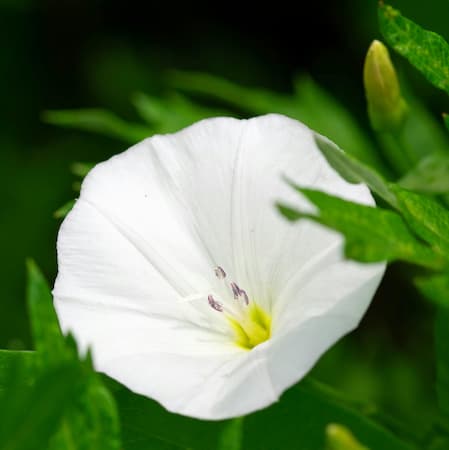How to Grow Moonflower Vines

About Growing Moonflower Plants in Your Home Flower Garden
Moonflower plants are nocturnal bloomers, perfect for night owls and late night strollers. After sunset, these huge white flowers bloom and glow all night in the moonlight. Then, as the sun rises, they close their fragrant blooms. Moonflower vines grow as much as 20 feet tall in a single year. They are perennial in their native tropical homes. However they are grown as annuals in more northerly areas. This guide on “How to Grow Moonflower Vines” will help you to grow a beautiful nighttime bloomers.
Moonflower plants are prolific climbers with attractive leaves. When growing moonflowers, make sure to plant them where they can climb quickly towards the moon. Plant them along patios and sidewalks, where people are likely to be in early evening hours.
Because the flowers bloom at night, the flowers are pollinated by nighttime insects. Moths are a common pollinator.
The plants symbolize love and romance.
Moonflower Vine Plant Specifications
Flower Colors: White
Flowers Bloom: Summer through Fall.
Plant Height: Plants grow 10 – 20 feet tall in a single season.
Ideal Soil pH: 6.0 – 7.5.
Light Requirement: Full sun.
Hardiness Zones: 10 – 12
Are Plants Toxic? Yes.
Deer Resistant? Yes. It is deer and rabbit resistant.
Native To: Tropical and sub-tropical North America and South America.
Plant Type: Annuals and Perennials
Botanical Name: Ipomea
Are Moonflower Plants Edible?
NO!
All parts of Moonflower plants are highly poisonous. They are toxic to humans, pets and other animals.
The plants are poisonous if ingested. But, it is not harmful to touch them.
Keep this plant away from small children and pets.
Medicinal Uses for Moonflower Plants
Despite being a toxic plant, Moonflower shave a variety of medicinal applications. Here are some of them:
- Use it as a topical treatment for skin disorders.
- Moonflowers can ease digestive problems.
- It is used as an antispasmodic.
- Use it to treat anxiety.
- It treats insomnia.
Light Requirements
Grow Moonflower plants in bright, direct, full sun. Select a planting location where they will receive six to eight housers of full sunlight.
The plants grow in partial sunlight. However, if they do not receive sufficient sunlight, the vine may not grow to its full potential. And, the vine may produce fewer blooms.
Moonflower Vine Plant Propagation
Moonflowers are grown from seeds. Sow Moonflower seeds directly into your flower garden.
Sow Moonflower seeds early in the season after all danger of frost. Cover seeds with 1/4″ soil. They can also be started indoors 3-4 weeks before the last frost to get a jump start on the season. Water thoroughly once. They germinate easily and will grow quickly.
Tip: Soak seeds overnight to improve germination rates.
Thin or space your plants to at least 6″ apart.
Days to Germination: 5 – 10 days.
How to Grow Moonflower Plants
Moonflower plants like full to the partial sun during the daylight hours. You will like the fact that Moonflower plants thrive in poor and dry soils. That makes them useful in areas where many other popular plants just won’t grow. It also makes them easy to grow with little care or attention. Just plant them, and away they grow!
Garden Tip: The plants can grow in a large flowerpot on a balcony or raised deck. Let the vines hang down or provide something for them to climb. Also, you can let them grow along the railing.
When the plants are young, you may want to train the vines to go up a trellis or post. Once they catch onto an item to climb, they need no further training.
Add mulch around the plants for appearance and to keep weeds down. Fertilizer can be applied but is usually not needed.
Moonflowers are susceptible to frost. They may survive the first light frost with only a little damage. Moonflowers are most often planted near a house or building. So, a light frost may kill the plants away from the house, yet spare your Moonflowers for another day. Annual varieties are killed by a hard frost or freeze. Perennial varieties will go dormant at this point.
For perennial moonflower varieties, cut the plant back close to the ground after they have gone dormant in the Fall.
Insects and Plant Disease
Insects and disease problems are not infrequent. If problems occur, treat Moonflower plants early with organic or chemical insect repellents and fungicide.
Also see: Plant Problems – Identify the causes and find the cures.
Pruning Moonflower Vines
Moonflowers are basically a no maintenance plant.
Do not prune the plants. And, especially do not snip off the growing tips. Just “Let ’em grow”.
For a tidy appearance, remove the occasional dead or damaged leaves. You do not need to deadhead spent blooms.
Related Articles
Also, people who read this article will like:
How to Grow Moonflower Plants – by Garden Hobbies
Please support our site. Shop for:
- rmmatthews100@hotmail.com
- 585-721-6528
- Rochester, NY
©1999-2024 GardenersNet.Com, All Rights Reserved

